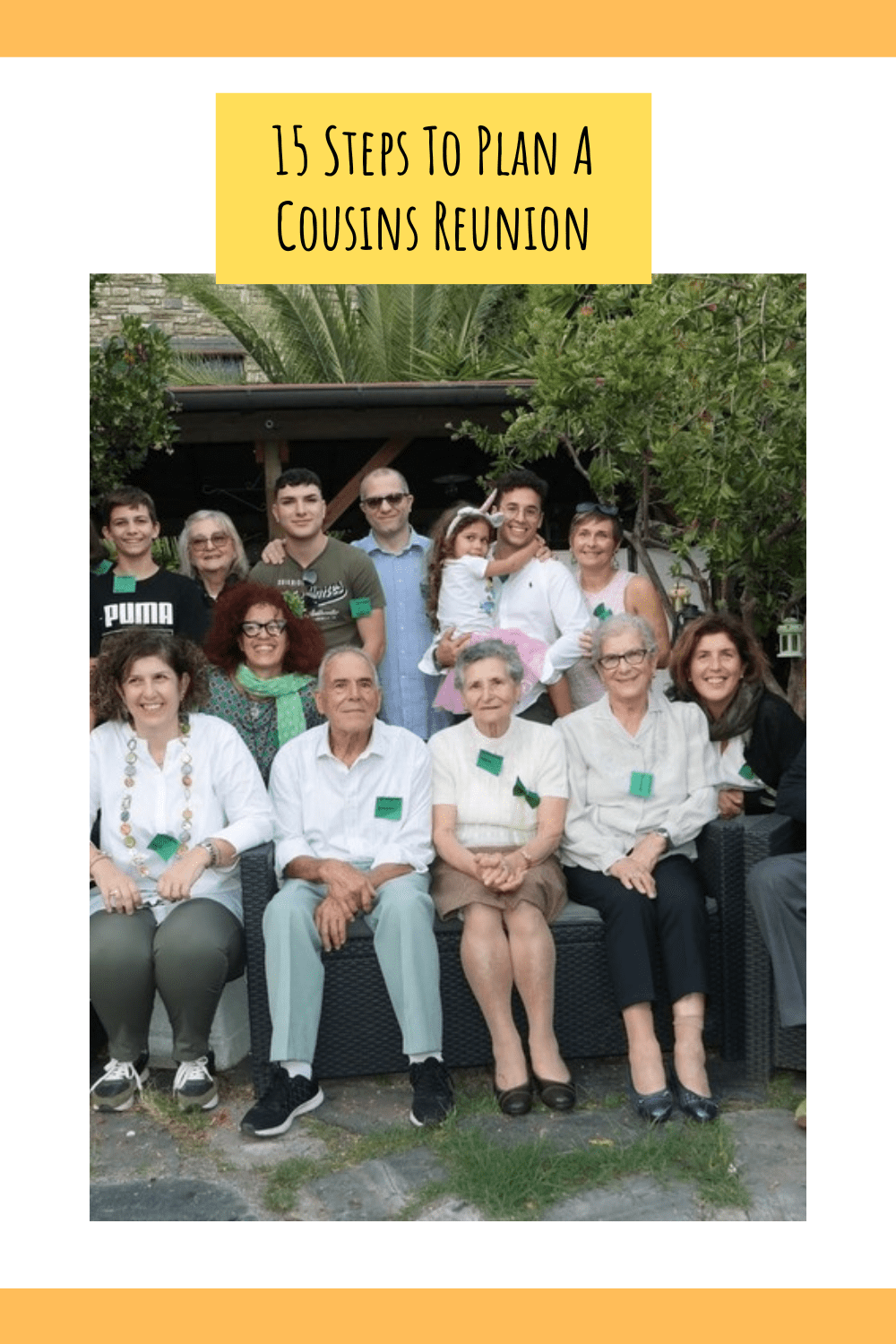I recently wrote a post about a family’s highly satisfying cousins reunion in Liguria, Italy. It made me think about some elements that need to be considered in planning such an event, either close to home or across the ocean.
Whether it’s family, friends or colleagues, it takes considerable effort to gather any group together. So before you take on the task of a cousins reunion, think about the raison d’etre for the event and the potential rewards.
The most obvious one is that cousins are the keepers of our history and memories.
They likely knew your parents, grandparents, and aunts and uncles. They can offer an opportunity to better understand your past and theirs.
Additionally, you may be able to renew relationships that may have frayed over the years or forge new ones.
Sounds like something you might want to do?
15 Steps For Planning a Cousins Reunion
 Here are 15 steps entailed in planning a cousins reunion:
Here are 15 steps entailed in planning a cousins reunion:
1 – Prepare to dig in
Pulling the event together and developing a guest list will require some research up front.
If you have lost touch with many cousins—-or you have a very large group of them— it may take considerable legwork to locate all the potential participants.
Bear in mind, it can be particularly challenging to find female cousins who have taken their husbands’ surnames or to track down people you’ve lost touch with years ago and have moved many times.
2 – Gauge preliminary interest
Once you have a potential guest list, you’ll need to get a read on whether there is sufficient interest among the group.
This can be done via email, snail mail or by phone, or by some combination of these approaches.
3 – Determine whether you are ready to take the lead. Solicit volunteers
Every group requires leadership to get things done. Determine who will coordinate the effort to bring cousins together.
If you are reading this post, the odds are likely that that person will be you. However, it can be extremely helpful, even vital, to identify a small group of volunteers to assist you and to whom you can delegate various tasks.
4 – Get out your calendar
It is essential to propose a time for the get-together, well in advance. People are busy and their lives are filled with commitments that might include work, school calendars and previously planned trips/vacations.
Firming up a date with sufficient lead time will help assure that as many cousins as possible can participate.
Many families choose a date of significance, for example, one that celebrates an elder’s family member’s milestone birthday or anniversary.
5 – Decide on a location
In choosing a location for the get-together, a number of considerations will also come into play, among them geography, cost and meaningfulness of the location.
If most of the group isn’t spread out too far geographically, it could be prudent to pick a central location that is convenient to most people.
Another more ambitious (and more costly) possibility is to choose a destination close to where your cousins grew up or their ancestral home.
For example, if your clan is Irish, they might relish the opportunity to visit Dublin or another city in Ireland. If your group includes offspring of Holocaust survivors, they may want to return to the country where they once had family.
When a group is far-flung, it can be especially challenging to corral people, especially given the cost of long-distance travel.
6 – Design a program or itinerary
What contours do you envision for the event? Do you want to invite everyone to a meal, perhaps a luncheon or dinner?
If it is at a distant location for most attendees and a multi-day event, think about other interesting activities that might bring people together. For example, if it is held in a city, you might include optional visits to museums or other attractions.
If teenagers and younger children are likely to attend, make sure the program/event space addresses their interests and activity levels, too.
7 – Choose a venue
Sounds easier said than done. Even a luncheon will require a venue large enough to accommodate your group.
You will also want a place that can promise you some privacy, perhaps a separate room off a main dining room.
8 – Develop a budget
Find out the cost of a preset meal, possibly with some choices to accommodate different dietary requirements. Do you have to pay an extra fee for the event space? Gratuities?
If it’s even more ambitious than a meal, planning the budget will be more complicated. But once you have an estimated cost per person, you can share that information with participants.
10 – Finalize the guest list and determine who will commit to attend
It’s most likely that many of the cousins will want to bring their spouses, partners and offspring. Try to get an accurate headcount.
When you have the estimated costs and the final guest list nailed down, asking people for a deposit is a good way to better gauge their buy-in and get them vested in the event. (In many cases, the venue will require a deposit in advance of the event).
11 – Assure the event won’t be a superspreader and that people of all ages will feel comfortable with “the rules”
Unfortunately, COVID-19 is still a risk at indoor gatherings.
Do you want to ask participants to affirm that they are vaccinated to attend? Do you want people to take rapid tests before the event? Would your group prefer an outdoor venue?
Let people know what rules are decided upon in advance.
12 – Flesh out the final program for the cousins reunion
Some of the participants may never have met and others may not have seen each other for a long time.
It’s a good idea to share the guest list with the group in advance. Also, name tags that are large enough to read) at the event are a nice way for people to easily identify who’s who.
Do you want to start with a toast? Cocktail hour? Sharing of stories at the table? A group activity can break the ice and help people feel comfortable with one another.
Do you want to ask each participant to be prepared to share a family anecdote?
Choosing a menu with dishes that reflect the family’s history also has a way of bringing people together.
13 – Confirm all the details and cross all the t’s and dot all the i’s
A week or two before the event, check with the venue and with participants to make sure plans are all set. Remind attendees how much you are looking forward to seeing them.
14 – Choose a family documentarian
Everyone will love to see photos of the event afterward, especially those who weren’t able to participate.
Find out if there are one or more shutterbugs among the group who would like to collect candid photos from different family members and organize them for sharing after the event.
Be sure to take several formal group photos, too.
Printing inexpensive tee shirts or baseball caps with the family name and the date of the event can lay the foundation for a great group photo. Etsy has some creative ideas for personalized cousins reunion items.
Finding a volunteer videographer in your cousins group can also add a nice touch.
15 – Reap the rewards
Blood ties among cousins confer a strong emotional bond. And compared to ones with siblings and parents, the relationships are volitional rather than obligatory.
So, with solid planning, all should go well. And next year’s event will be even easier to pull off!
On wikiHow: How to Plan and Organize a Family Reunion





